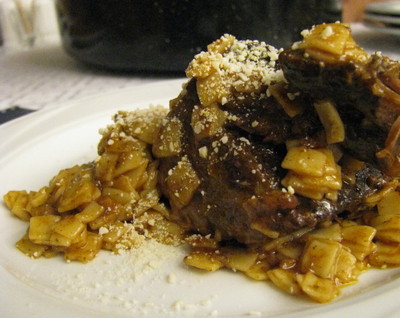Yiouvetsi – easy beef ‘n’ pasta stew
This has to be the easiest stew recipe I know. The laziest cook in the world could make this, and produce something as delicious to eat as it is effortless to make. I swiped it from Susanna Spiliopoulos of Hotel Pelops in Olympia, Greece, when we stayed with her this spring.

Susanna has her own (very highly regarded) catering business and kindly shared some of her numerous culinary tips with us during our two day cooking spree in her squeaky clean professional kitchen. For Susanna, good cooking is all about good oil, by which she of course means good Greek extra virgin olive oil, which in her case is pressed from her family’s very own olive grove up the road.
Recipe: Yiouvetsi – easy beef stew.pdf
Serves: 6-8
Total preparation time: 10 mins
Total cooking time: 4+ hours
3 lbs stewing beef in one piece (Susanna uses a piece of the thigh referred to as ‘the mouse’ in Greek)
water
3 cinnamon sticks
3 rounded tbsps concentrated tomato paste
1 tbsp black peppercorns
a handful of rock salt
180ml (3/4 cup) olive oil (“You must have good oil!”)
600g tiny dried pasta such as orzo (Susanna uses hilopitaki – tiny flat squares of dried egg pasta)
Grated aged pecorino (/parmesan) to serve (Susanna uses mizithra, a byproduct of Feta-making)
- Heat oven to 125C (260F), with a rack just below the middle.
- Cut meat into as many pieces as there are people, across the grain. (If there are large nasty pieces of fat, sinew or silverskin you can remove them, but don’t exert yourself too much – it’s going to cook such a long time that most will just melt away.)
 Place these large chunks into a large casserole pot and pour in enough water to just cover them. Throw in cinnamon sticks, tomato paste, peppercorns, salt and olive oil.
Place these large chunks into a large casserole pot and pour in enough water to just cover them. Throw in cinnamon sticks, tomato paste, peppercorns, salt and olive oil.- Cover casserole with its lid and cook slowly in oven for approx 4 hours or until meat is incredibly tender. Once or twice, if possible, tear yourself away from the newspaper/kids/garden and give the meat a stir.
- Now mix the pasta into the stew liquid, increase temperature to 175C (350F) and return to oven, uncovered, for 15 or so mins until the pasta is done. The idea is for the pasta to absorb almost all the liquid, so add more water (or pasta) if you think it will need it. Give the pasta a stir (“just a little tickle”) once or twice as it cooks.
- Serve with grated cheese.
Variations:
- You could try this with any other good stewing meat, such as mutton or venison. I’m sure lamb and pork shoulder would also work.
- And of course you could vary the flavours accordingly. So with lamb or mutton you could continue down the spice route and add cumin, coriander and chilli. With pork you could use bay and/or fennel with garlic cloves instead of the cinnamon. In both cases I’m sure a strip or two of lemon zest would be lovely. And with venison you could use a classic combo like juniper (not too many), orange zest and rosemary and/or sage.
- If you’d like to be more particular about the quantity of salt, generously sprinkle your chunks of meat (the thicker they are, the more they’ll need) with a finer salt at least an hour and up to a day in advance, so that it penetrates right through. In this case don’t add any to the stewing liquid, but do check it before adding the pasta and add some then if you think it’s bland.
- If you’d like to create more work for yourself, you could of course marinate the meat in advance. This would be a good idea if using game or a particularly tough piece from an older animal. You could then cook the meat in its marinade, diluted with water or stock.

 Follow
Follow
Comments are closed